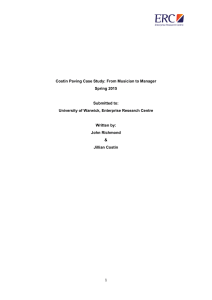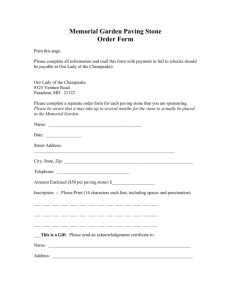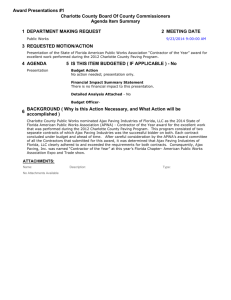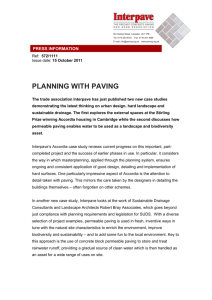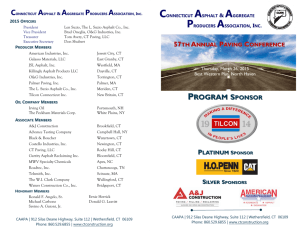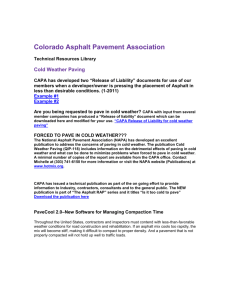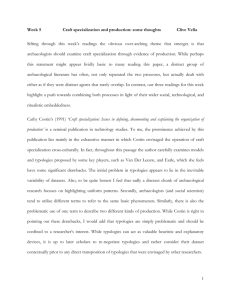Teaching Note - Enterprise Research Centre
advertisement
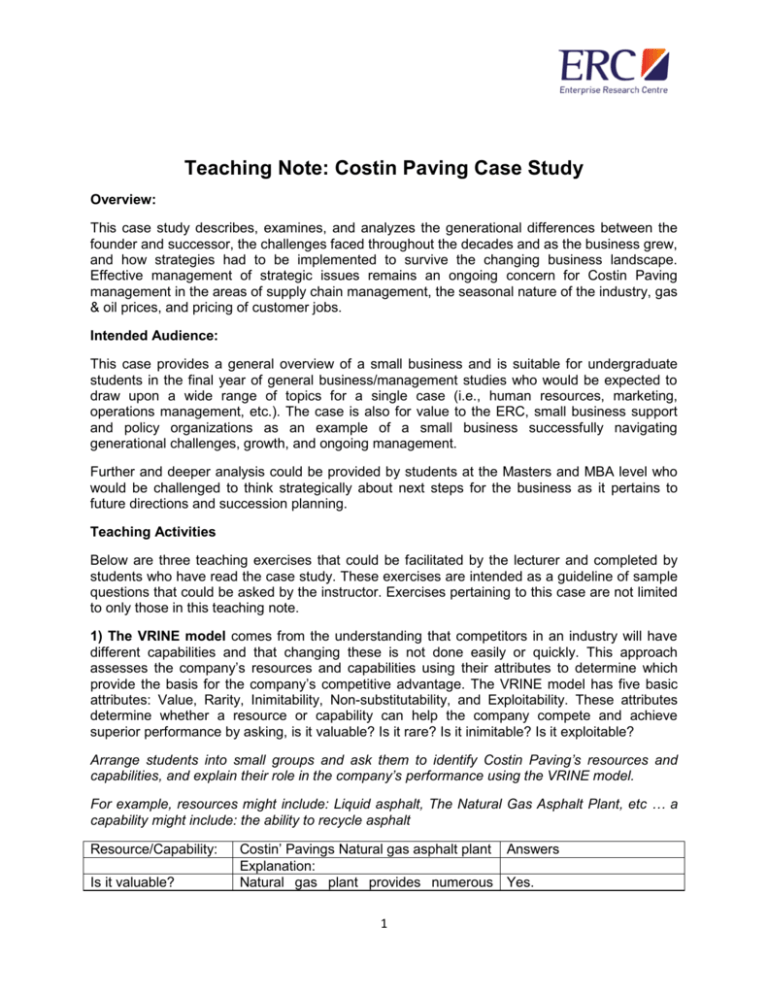
Teaching Note: Costin Paving Case Study Overview: This case study describes, examines, and analyzes the generational differences between the founder and successor, the challenges faced throughout the decades and as the business grew, and how strategies had to be implemented to survive the changing business landscape. Effective management of strategic issues remains an ongoing concern for Costin Paving management in the areas of supply chain management, the seasonal nature of the industry, gas & oil prices, and pricing of customer jobs. Intended Audience: This case provides a general overview of a small business and is suitable for undergraduate students in the final year of general business/management studies who would be expected to draw upon a wide range of topics for a single case (i.e., human resources, marketing, operations management, etc.). The case is also for value to the ERC, small business support and policy organizations as an example of a small business successfully navigating generational challenges, growth, and ongoing management. Further and deeper analysis could be provided by students at the Masters and MBA level who would be challenged to think strategically about next steps for the business as it pertains to future directions and succession planning. Teaching Activities Below are three teaching exercises that could be facilitated by the lecturer and completed by students who have read the case study. These exercises are intended as a guideline of sample questions that could be asked by the instructor. Exercises pertaining to this case are not limited to only those in this teaching note. 1) The VRINE model comes from the understanding that competitors in an industry will have different capabilities and that changing these is not done easily or quickly. This approach assesses the company’s resources and capabilities using their attributes to determine which provide the basis for the company’s competitive advantage. The VRINE model has five basic attributes: Value, Rarity, Inimitability, Non-substitutability, and Exploitability. These attributes determine whether a resource or capability can help the company compete and achieve superior performance by asking, is it valuable? Is it rare? Is it inimitable? Is it exploitable? Arrange students into small groups and ask them to identify Costin Paving’s resources and capabilities, and explain their role in the company’s performance using the VRINE model. For example, resources might include: Liquid asphalt, The Natural Gas Asphalt Plant, etc … a capability might include: the ability to recycle asphalt Resource/Capability: Is it valuable? Costin’ Pavings Natural gas asphalt plant Answers Explanation: Natural gas plant provides numerous Yes. 1 benefits to the company including protection against fluctuating oil prices, a constant supply of gas, and minimizing risk to the environment Is it rare? It is rare in the local geographic area. However firms with enough capital should be able to invest in their own natural gas plants. Is it Substitutes do exist to natural gas inimitable/substitutes? however it is not easily imitated by competitors without capital investment. Is it exploitable? Yes, Costin Paving exploits this resource to gain competitive advantage in the industry. For example, they are not reliant on gasoline supply trucks to keep their asphalt plant active, which gives them advantage over competitors. 2 No, but upfront capital required for acquiring. Yes. Yes. 2) Value-chain analysis takes the view that the business’s margin or profit depends on the activities it performs. Value-chain analysis is complementary to the VRINE model because activities are performed using the resources and capabilities of the company. The activities of the firm are important because they determine, at the end of the day, what the customer receives and price they are willing to pay. By performing activities, Costin Paving incurs cost. The difference between the cost of all activities associated with the product, and the price paid for the product by the customer, is the value or profit margin created by the company. For example, the value created by company can be increased by getting the customer to pay more by providing more desirable products and services at a lower cost. Value chain analysis could be utilized by students to help Costin Paving in three different ways: 1) It can help determine how changing activities along the value chain can increase the value created by the company, 2) It can help explain why competitors in the same industry and with the same activities create different amounts of value, 3) It can help determine which activities Costin Paving may outsource. The starting point of all value-chain analysis is identifying the activities and linkages between them. Below is Michael Porter’s generic value-chain analysis diagram which identifies the activities and the linkages between them. Arrange students into small groups and ask them to identify explain how value-chain activities are related to firm performance and competitive advantage. For example, The Instructor and Students may wish to focus on: 3 • • • How Costin Paving can outperform rivals by finding ways to perform some value-chain activities better than its rivals, or to find different ways of performing activities altogether. Whether outsourcing of some value-chain activities is appropriate or not for Costin Paving. Strategic reconfiguration of Costin Paving’s value-chain activities to deliver comparable value at lower cost (than rivals). 3) Our analysis so far has focused on the attributes & resources of the firm and its ability to produce value as it pertains to competitive advantage. Taking more of a macro view which covers the larger political, economic, social, technical, environmental, and legal issues will allow Costin Paving to analyze the external environment in which they are doing business. PESTEL analysis is a type of analytical technique which can enable the company to structure analysis of their external environment by looking at political, economic, social, technical, environmental, and legal issues. When applying the analysis only factors that could have a potential impact on the company in the future are considered. Have the students complete a PESTEL analysis for Costin Paving to identify the macro characteristics of the external environment, to help the company better understand the opportunities and threats they face by articulating the future business landscape and how the business might compete profitably. For example, By examining, by examining the political environment Costin Paving can gain a better understanding of the political underpinnings of small business environment in Nova Scotia. … environmental issues are increasingly a concern for NSRBA members, an understanding of current and upcoming government policy and best practices pertaining to environmental matters would be helpful to guide the sustainability of Costin Paving’s practices. … by examining the social context may identify future human resource challenges due to increasing outmigration of workers in manual labour and trades positions and an aging population. 4 If there is time, the course instructor may also wish to ask students to apply Porters five factors model to identify the major features of the industry and forces that affect industry profitability. 4
